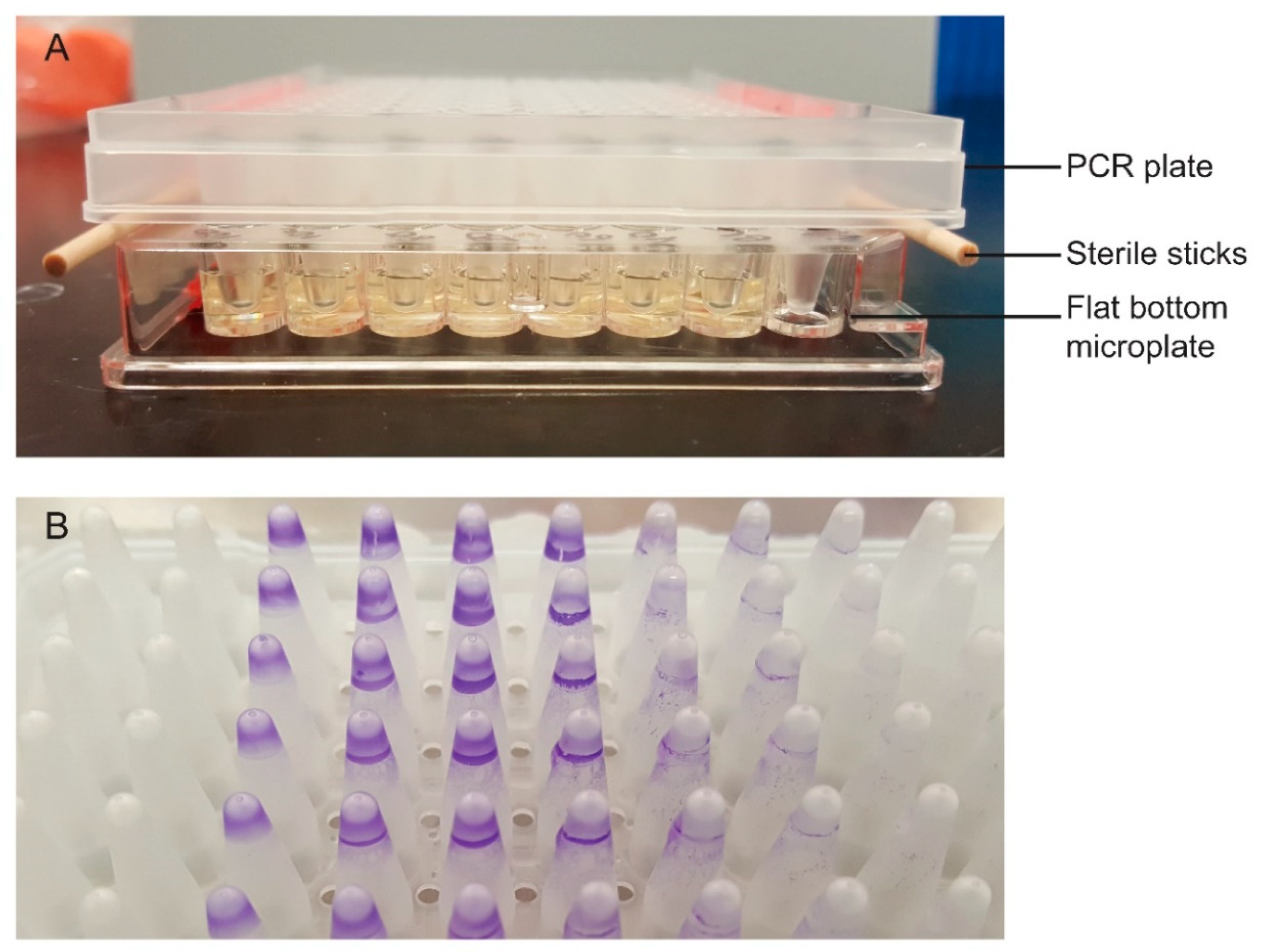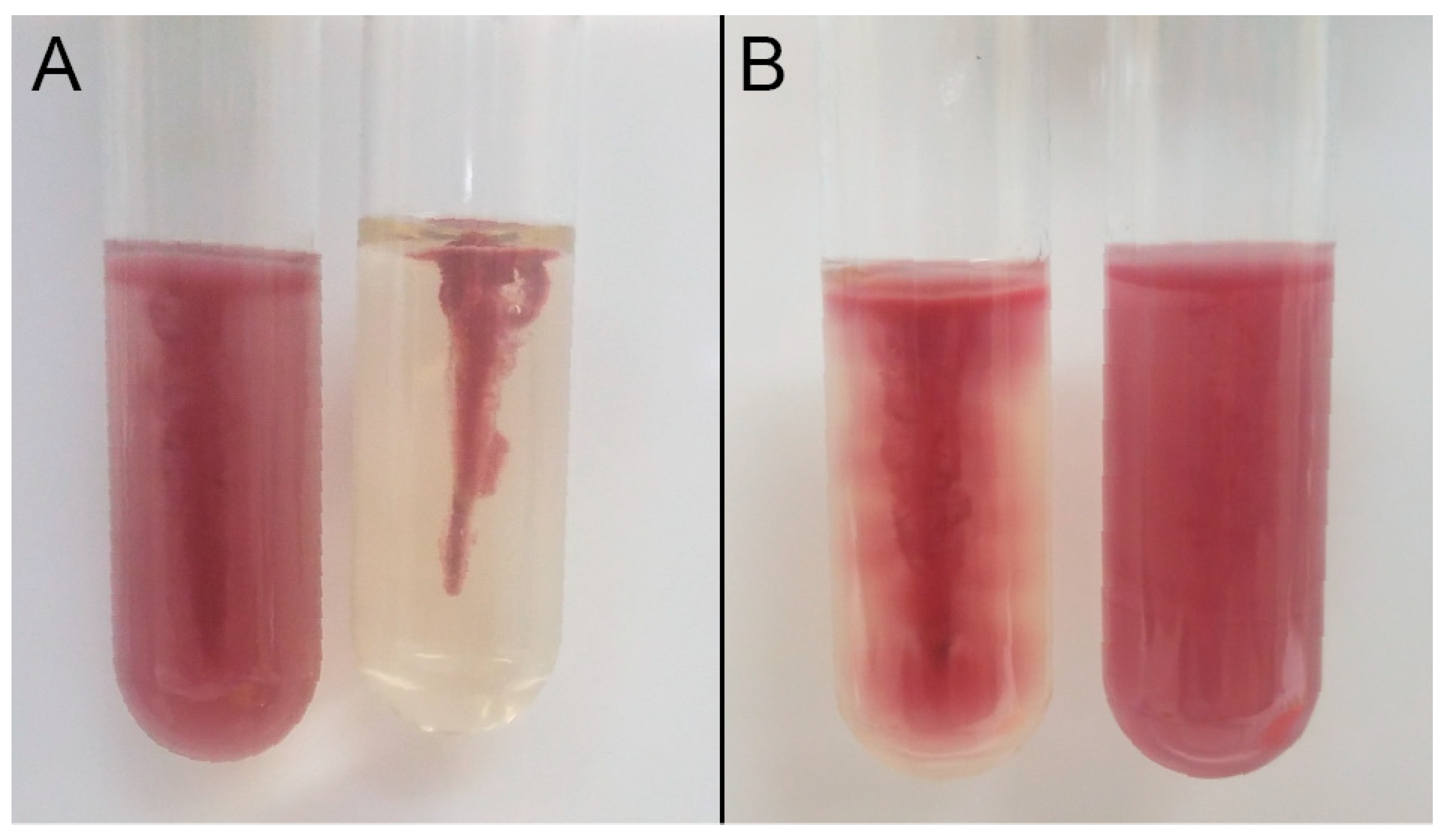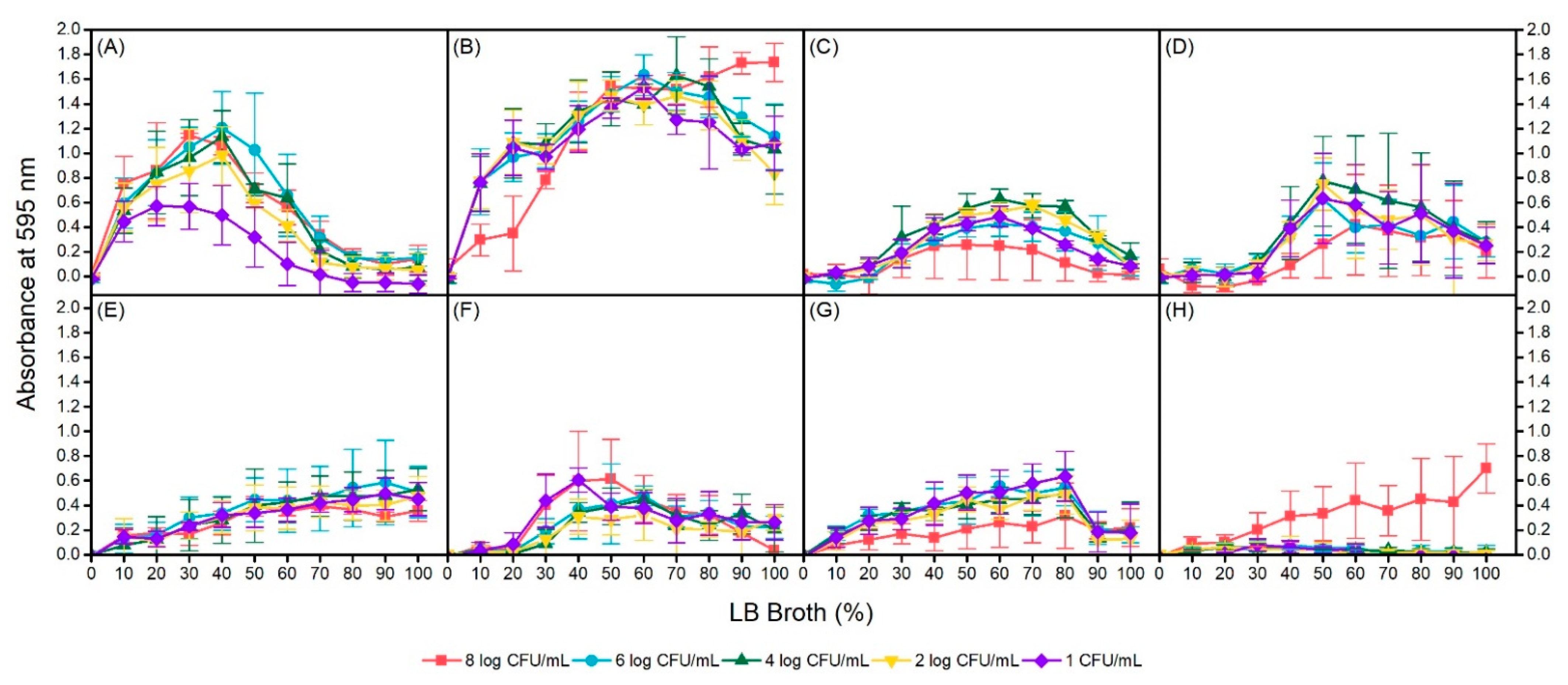Phenotypic and Genetic Determination of Biofilm Formation in Heat Resistant Escherichia coli Possessing the Locus of Heat Resistance
Abstract
:1. Introduction
2. Materials and Methods
2.1. Bacterial Isolates and Growth Conditions
2.2. Detection of Biofilm Formation by Crystal Violet Staining
2.3. Determination of Optimal Biofilm Formation Conditions
2.4. Genomic DNA Isolation, Whole Genome Sequencing, and Analysis for Biofilm-Associated Genes
2.5. Motility Status
2.6. Statistical Analysis
3. Results
3.1. Virulence Characteristics and Motility of E. coli Isolates
3.2. Optimization of the Two-Component Apparatus for E. coli
3.3. Determination of Optimal Biofilm Formation Conditions
3.4. Genetic Analysis of Biofilm Formation-Associated Genes
4. Discussion
5. Conclusions
Author Contributions
Funding
Acknowledgments
Conflicts of Interest
References
- Kaper, J.B.; Nataro, J.P.; Mobley, H.L.T. Pathogenic Escherichia coli. Nat. Rev. Microbiol. 2004, 2, 123–140. [Google Scholar] [CrossRef] [PubMed]
- Mainil, J. Escherichia coli virulence factors. Vet. Immunol. Immunopathol. 2013, 152, 2–12. [Google Scholar] [CrossRef] [Green Version]
- Sharma, G.; Sharma, S.; Sharma, P.; Chandola, D.; Dang, S.; Gupta, S.; Gabrani, R. Escherichia coli biofilm: Development and therapeutic strategies. J. Appl. Microbiol. 2016, 121, 309–319. [Google Scholar] [CrossRef] [PubMed] [Green Version]
- Reisner, A.; Maierl, M.; Jörger, M.; Krause, R.; Berger, D.; Haid, A.; Tesic, D.; Zechner, E.L. Type 1 Fimbriae Contribute to Catheter-Associated Urinary Tract Infections Caused by Escherichia coli. J. Bacteriol. 2014, 196, 931–939. [Google Scholar] [CrossRef]
- Gomes, L.C.; Silva, L.N.; Simões, M.; Melo, L.F.; Mergulhão, F.J. Escherichia coli adhesion, biofilm development and antibiotic susceptibility on biomedical materials. J. Biomed. Mater. Res. Part A 2015, 103, 1414–1423. [Google Scholar] [CrossRef] [Green Version]
- Schiebel, J.; Böhm, A.; Nitschke, J.; Burdukiewicz, M.; Weinreich, J.; Ali, A.; Roggenbuck, D.; Rödiger, S.; Schierack, P. Genotypic and Phenotypic Characteristics Associated with Biofilm Formation by Human Clinical Escherichia coli Isolates of Different Pathotypes. Appl. Environ. Microbiol. 2017, 83, 3670–3680. [Google Scholar] [CrossRef] [Green Version]
- Caprioli, A.; Scavia, G.; Morabito, S. Public Health Microbiology of Shiga Toxin-Producing Escherichia coli. Microbiol. Spectr. 2013, 1–12. [Google Scholar] [CrossRef] [Green Version]
- Chekabab, S.M.; Paquin-Veillette, J.; Dozois, C.M.; Harel, J. The ecological habitat and transmission of Escherichia coli O157:H7. FEMS Microbiol. Lett. 2013, 341, 1–12. [Google Scholar] [CrossRef]
- Oloketuyi, S.F.; Khan, F. Strategies for Biofilm Inhibition and Virulence Attenuation of Foodborne Pathogen-Escherichia coli O157:H7. Curr. Microbiol. 2017, 74, 1477–1489. [Google Scholar] [CrossRef] [PubMed]
- Minihan, D.; Whyte, P.; O’Mahony, M.; Collins, J.D. The effect of commercial steam pasteurization on the levels of Enterobacteriaceae and Escherichia coli on naturally contaminated beef carcasses. J. Vet. Med. Ser. B Infect. Dis. Vet. Public Health 2003, 50, 352–356. [Google Scholar] [CrossRef] [PubMed]
- Yang, X.; Badoni, M.; Tran, F.; Gill, C.O. Microbiological Effects of a Routine Treatment for Decontaminating Hide-On Carcasses at a Large Beef Packing Plant. J. Food Prot. 2015, 78, 256–263. [Google Scholar] [CrossRef]
- Mercer, R.G.; Zheng, J.; Garcia-Hernandez, R.; Ruan, L.; Gänzle, M.G.; McMullen, L.M. Genetic determinants of heat resistance in Escherichia coli. Front. Microbiol. 2015, 6, 1–13. [Google Scholar] [CrossRef] [PubMed] [Green Version]
- Wang, R.; Kalchayanand, N.; King, D.A.; Luedtke, B.E.; Bosilevac, J.M.; Arthur, T.M. Biofilm Formation and Sanitizer Resistance of Escherichia coli O157:H7 Strains Isolated from “High Event Period” Meat Contamination. J. Food Prot. 2014, 77, 1982–1987. [Google Scholar] [CrossRef] [PubMed]
- Ma, A.; Chui, L. Identification of heat resistant Escherichia coli by qPCR for the locus of heat resistance. J. Microbiol. Methods 2016, 133, 87–89. [Google Scholar] [CrossRef] [PubMed]
- Ma, A.; Glassman, H.; Chui, L. Characterization of Escherichia coli possessing the locus of heat resistance isolated from human cases of acute gastroenteritis. Food Microbiol. 2020, 88, 103400. [Google Scholar] [CrossRef]
- Aslam, M.; Greer, G.G.; Nattress, F.M.; Gill, C.O.; McMullen, L.M. Genotypic analysis of Escherichia coli recovered from product and equipment at a beef-packing plant. J. Appl. Microbiol. 2004, 97, 78–86. [Google Scholar] [CrossRef]
- Zhi, S.; Banting, G.; Li, Q.; Edge, T.A.; Topp, E.; Sokurenko, M.; Scott, C.; Braithwaite, S.; Ruecker, N.J.; Yasui, Y.; et al. Evidence of Naturalized Stress-Tolerant Strains of Escherichia coli in Municipal Wastewater Treatment Plants. Appl. Environ. Microbiol. 2016, 82, 5505–5518. [Google Scholar] [CrossRef] [Green Version]
- Hammar, M.; Bian, Z.; Normark, S. Nucleator-dependent intercellular assembly of adhesive curli organelles in Escherichia coli. Proc. Natl. Acad. Sci. USA 1996, 93, 6562–6566. [Google Scholar] [CrossRef] [Green Version]
- Loferer, H.; Hammar, M.; Normark, S. Availability of the fibre subunit CsgA and the nucleator protein CsgB during assembly of fibronectin-binding curli is limited by the intracellular concentration of the novel lipoprotein CsgG. Mol. Microbiol. 1997, 26, 11–23. [Google Scholar] [CrossRef] [Green Version]
- Evans, M.L.; Chorell, E.; Taylor, J.D.; Åden, J.; Götheson, A.; Li, F.; Koch, M.; Sefer, L.; Matthews, S.J.; Wittung-Stafshede, P.; et al. The Bacterial Curli System Possesses a Potent and Selective Inhibitor of Amyloid Formation. Mol. Cell 2015, 57, 445–455. [Google Scholar] [CrossRef] [Green Version]
- Hammar, M.; Arnqvist, A.; Bian, Z.; Olsén, A.; Normark, S. Expression of two csg operons is required for production of fibronectin- and Congo red-binding curli polymers in Escherichia coli K-12. Mol. Microbiol. 1995, 18, 661–670. [Google Scholar] [CrossRef] [PubMed]
- Barnhart, M.M.; Chapman, M.R. Curli biogenesis and function. Annu. Rev. Microbiol. 2006, 60, 131–147. [Google Scholar] [CrossRef] [PubMed] [Green Version]
- García-Contreras, R.; Zhang, X.-S.; Kim, Y.; Wood, T.K. Protein Translation and Cell Death: The Role of Rare tRNAs in Biofilm Formation and in Activating Dormant Phage Killer Genes. PLoS ONE 2008, 3, e2394. [Google Scholar] [CrossRef]
- Zogaj, X.; Nimtz, M.; Rohde, M.; Bokranz, W.; Römling, U. The multicellular morphotypes of Salmonella typhimurium and Escherichia coli produce cellulose as the second component of the extracellular matrix. Mol. Microbiol. 2001, 39, 1452–1463. [Google Scholar] [CrossRef]
- Wang, X.; Preston, J.F.; Romeo, T. The pgaABCD Locus of Escherichia coli Promotes the Synthesis of a Polysaccharide Adhesin Required for Biofilm Formation. J. Bacteriol. 2004, 186, 2724–2734. [Google Scholar] [CrossRef] [Green Version]
- Fattahi, S.; Kafil, H.S.; Nahai, M.R.; Asgharzadeh, M.; Nori, R.; Aghazadeh, M. Relationship of biofilm formation and different virulence genes in uropathogenic Escherichia coli isolates from Northwest Iran. GMS Hyg. Infect. Control 2015, 10, 11. [Google Scholar] [CrossRef]
- Wallecha, A.; Oreh, H.; van der Woude, M.W.; DeHaseth, P.L. Control of Gene Expression at a Bacterial Leader RNA, the agn43 Gene Encoding Outer Membrane Protein Ag43 of Escherichia coli. J. Bacteriol. 2014, 196, 2728–2735. [Google Scholar] [CrossRef] [PubMed] [Green Version]
- Chauhan, A.; Sakamoto, C.; Ghigo, J.-M.; Beloin, C. Did I Pick the Right Colony? Pitfalls in the Study of Regulation of the Phase Variable Antigen 43 Adhesin. PLoS ONE 2013, 8, e73568. [Google Scholar] [CrossRef]
- Rodrigues, D.F.; Elimelech, M. Role of type 1 fimbriae and mannose in the development of Escherichia coli K12 biofilm: From initial cell adhesion to biofilm formation. Biofouling 2009, 25, 401–411. [Google Scholar] [CrossRef]
- Gally, D.L.; Leathart, J.; Blomfield, I.C. Interaction of FimB and FimE with the fim switch that controls the phase variation of type 1 fimbriae in Escherichia coli K-12. Mol. Microbiol. 1996, 21, 725–738. [Google Scholar] [CrossRef]
- Burmølle, M.; Bahl, M.I.; Jensen, L.B.; Sørensen, S.J.; Hansen, L.H. Type 3 fimbriae, encoded by the conjugative plasmid pOLA52, enhance biofilm formation and transfer frequencies in Enterobacteriaceae strains. Microbiology 2008, 154, 187–195. [Google Scholar] [CrossRef] [Green Version]
- Allen, B.L.; Gerlach, G.F.; Clegg, S. Nucleotide sequence and functions of mrk determinants necessary for expression of type 3 fimbriae in Klebsiella pneumoniae. J. Bacteriol. 1991, 173, 916–920. [Google Scholar] [CrossRef] [Green Version]
- Sauer, F.G.; Barnhart, M.; Choudhury, D.; Knight, S.D.; Waksman, G.; Hultgren, S.J. Chaperone-assisted pilus assembly and bacterial attachment. Curr. Opin. Struct. Biol. 2000, 10, 548–556. [Google Scholar] [CrossRef]
- R Core Team. R: A Language and Environment for Statistical Computing; R Foundation for Statistical Computing: Vienna, Austria, 2021; Available online: https://www.R-project.org/ (accessed on 8 February 2021).
- Chui, L.; Li, V.; Fach, P.; Delannoy, S.; Malejczyk, K.; Patterson-Fortin, L.; Poon, A.; King, R.; Simmonds, K.; Scott, A.N.; et al. Molecular profiling of Escherichia coli O157:H7 and non-O157 strains isolated from humans and cattle in Alberta, Canada. J. Clin. Microbiol. 2015, 53, 986–990. [Google Scholar] [CrossRef] [PubMed] [Green Version]
- Zhi, S.; Banting, G.S.; Ruecker, N.J.; Neumann, N.F. Stress resistance in naturalised waste water E. coli strains. J. Environ. Eng. Sci. 2017, 12, 42–50. [Google Scholar] [CrossRef] [Green Version]
- Ryu, J.-H.; Beuchat, L.R. Biofilm Formation by Escherichia coli O157:H7 on Stainless Steel: Effect of Exopolysaccharide and Curli Production on Its Resistance to Chlorine. Appl. Environ. Microbiol. 2005, 71, 247–254. [Google Scholar] [CrossRef] [Green Version]
- Uhlich, G.A.; Cooke, P.H.; Solomon, E.B. Analyses of the Red-Dry-Rough Phenotype of an Escherichia coli O157:H7 Strain and Its Role in Biofilm Formation and Resistance to Antibacterial Agents. Appl. Environ. Microbiol. 2006, 72, 2564–2572. [Google Scholar] [CrossRef] [PubMed] [Green Version]
- Rounds, W.; Herd, D. The Cow’s Digestive System; Texas Agricultural Extension Service: College Station, TX, USA, 1987. [Google Scholar]
- Merritt, J.H.; Kadouri, D.E.; O’Toole, G.A. Growing and analyzing static biofilms. In Current Protocols in Microbiology; John Wiley & Sons, Inc.: Hoboken, NJ, USA, 2005; pp. 1–29. ISBN 9780471729259. [Google Scholar]
- Ceri, H.; Olson, M.E.; Stremick, C.; Read, R.R.; Morck, D.; Buret, A. The Calgary Biofilm Device: New technology for rapid determination of antibiotic susceptibilities of bacterial biofilms. J. Clin. Microbiol. 1999, 37, 1771–1776. [Google Scholar] [CrossRef] [Green Version]
- Leps, J.; Einschütz, K.; Langkabel, N.; Fries, R. Efficacy of knife disinfection techniques in meat processing. Meat Sci. 2013, 95, 185–189. [Google Scholar] [CrossRef] [PubMed]
- Marti, R.; Schmid, M.; Kulli, S.; Schneeberger, K.; Naskova, J.; Knøchel, S.; Ahrens, C.H.; Hummerjohann, J. Biofilm Formation Potential of Heat-Resistant Escherichia coli Dairy Isolates and the Complete Genome of Multidrug-Resistant, Heat-Resistant Strain FAM21845. Appl. Environ. Microbiol. 2017, 83, e00628-17. [Google Scholar] [CrossRef] [PubMed] [Green Version]
- Stanford, K.; Reuter, T.; Bach, S.J.; Chui, L.; Ma, A.; Conrad, C.C.; Tostes, R.; McAllister, T.A. Effect of severe weather events on the shedding of Shigatoxigenic Escherichia coli in slaughter cattle and phenotype of serogroup O157 isolates. FEMS Microbiol. Ecol. 2017, 1–12. [Google Scholar] [CrossRef] [Green Version]
- Pratt, L.A.; Kolter, R. Genetic analysis of Escherichia coli biofilm formation: Roles of flagella, motility, chemotaxis and type I pili. Mol. Microbiol. 1998, 30, 285–293. [Google Scholar] [CrossRef]
- Beloin, C.; Roux, A.; Ghigo, J.M. Escherichia coli biofilms. Curr. Top. Microbiol. Immunol. 2008, 322, 249–289. [Google Scholar] [CrossRef] [Green Version]
- Donlan, R.M. Biofilms: Microbial life on surfaces. Emerg. Infect. Dis. 2002, 8, 881–890. [Google Scholar] [CrossRef]
- Pratt, L.A.; Kolter, R. Genetic analyses of bacterial biofilm formation. Curr. Opin. Microbiol. 1999, 2, 598–603. [Google Scholar] [CrossRef]
- Sheikh, J.; Hicks, S.; Dall’Agnol, M.; Phillips, A.D.; Nataro, J.P. Roles for Fis and YafK in biofilm formation by enteroaggregative Escherichia coli. Mol. Microbiol. 2001, 41, 983–997. [Google Scholar] [CrossRef] [PubMed] [Green Version]
- Elliott, S.J.; Sperandio, V.; Giron, J.A.; Shin, S.; Mellies, J.L.; Wainwright, L.; Hutcheson, S.W.; McDaniel, T.K.; Kaper, J.B. The locus of enterocyte effacement (LEE)-encoded regulator controls expression of both LEE- and non-LEE-encoded virulence factors in enteropathogenic and enterohemorrhagic Escherichia coli. Infect. Immun. 2000, 68, 6115–6126. [Google Scholar] [CrossRef]
- Madic, J.; Peytavin De Garam, C.; Vingadassalon, N.; Oswald, E.; Fach, P.; Jamet, E.; Auvray, F. Simplex and multiplex real-time PCR assays for the detection of flagellar (H-antigen) fliC alleles and intimin (eae) variants associated with enterohaemorrhagic Escherichia coli (EHEC) serotypes O26:H11, O103:H2, O111:H8, O145:H28 and O157:H7. J. Appl. Microbiol. 2010, 109, 1696–1705. [Google Scholar] [CrossRef]
- Källenius, G.; Svenson, S.B.; Hultberg, H.; Möllby, R.; Helin, I.; Cedergren, B.; Winberg, J. Occurrence of P-Fimbriated Escherichia Coli in Urinary Tract Infections. Lancet 1981, 318, 1369–1372. [Google Scholar] [CrossRef]
- Lüthje, P.; Brauner, A. Ag43 promotes persistence of uropathogenic Escherichia coli isolates in the urinary tract. J. Clin. Microbiol. 2010, 48, 2316–2317. [Google Scholar] [CrossRef] [PubMed] [Green Version]
- Eberly, A.R.; Floyd, K.A.; Beebout, C.J.; Colling, S.J.; Fitzgerald, M.J.; Stratton, C.W.; Schmitz, J.E.; Hadjifrangiskou, M. Biofilm formation by uropathogenic escherichia coli is favored under oxygen conditions that mimic the bladder environment. Int. J. Mol. Sci. 2017, 18, 2077. [Google Scholar] [CrossRef] [PubMed] [Green Version]
- Kostakioti, M.; Hadjifrangiskou, M.; Hultgren, S.J. Bacterial biofilms: Development, dispersal, and therapeutic strategies in the dawn of the postantibiotic era. Cold Spring Harb. Perspect. Med. 2013, 3. [Google Scholar] [CrossRef] [Green Version]
- Jensen, B.H.; Olsen, K.E.P.; Struve, C.; Krogfelt, K.A.; Petersen, A.M. Epidemiology and clinical manifestations of enteroaggregative escherichia coli. Clin. Microbiol. Rev. 2014, 27, 614–630. [Google Scholar] [CrossRef] [Green Version]
- Bibbal, D.; Kérourédan, M.; Loukiadis, E.; Scheutz, F.; Oswald, E.; Brugère, H. Slaughterhouse effluent discharges into rivers not responsible for environmental occurrence of enteroaggregative escherichia coli. Vet. Microbiol. 2014, 168, 451–454. [Google Scholar] [CrossRef]
- Sauer, F.G.; Mulvey, M.A.; Schilling, J.D.; Martinez, J.J.; Hultgren, S.J. Bacterial pili: Molecular mechanisms of pathogenesis. Curr. Opin. Microbiol. 2000, 3, 65–72. [Google Scholar] [CrossRef]
- Marti, R.; Muniesa, M.; Schmid, M.; Ahrens, C.H.; Naskova, J.; Hummerjohann, J. Short communication: Heat-resistant Escherichia coli as potential persistent reservoir of extended-spectrum β-lactamases and Shiga toxin-encoding phages in dairy. J. Dairy Sci. 2016, 99, 8622–8632. [Google Scholar] [CrossRef] [PubMed] [Green Version]
- Croxen, M.A.; Law, R.J.; Scholz, R.; Keeney, K.M.; Wlodarska, M.; Finlay, B.B. Recent advances in understanding enteric pathogenic Escherichia coli. Clin. Microbiol. Rev. 2013, 26, 822–880. [Google Scholar] [CrossRef] [PubMed] [Green Version]




| Gene | Gene ID | Description | References |
|---|---|---|---|
| csgB | 947391 | Minor curlin subunit | [18] |
| csgA | 949055 | Major curlin subunit | [19] |
| csgC | 945623 | Inhibitor of CsgA amyloid formation | [20] |
| csgD | 949119 | DNA-binding transcriptional dual regulator of genes involved in curli assembly, transport, and structure components | [19,21] |
| csgE | 945711 | Specificity factor in the CsgG mediated outer membrane translocation of the curli subunits | [22] |
| csgF | 945622 | Acts in conjunction with CsgB to initiate curli subunit polymerisation | [22] |
| csgG | 945619 | Forms the secretion channel for curli subunits, providing stability to CsgA and CsgB during assembly | [19] |
| hha | 945098 | Represses the transcription of fimbrial genes | [23] |
| bcsA | 948053 | Catalytic subunit of cellulose synthase | [24] |
| bcsB | 948045 | Cellulose synthase periplasmic subunit | [24] |
| pgaC | 945606 | Poly-N-acetyl-D-glucosamine (PGA) synthase subunit mediating translocation and/or docking of PGA to the cell surface | [25] |
| papC | 7152342 | Export and assembly of pili subunits across the outer membrane needed for formation of P fimbriae | [26] |
| agn43 | 946540 | Autoaggregation factor promoting adhesion | [27,28] |
| fimA | 948838 | Major subunit of type 1 fimbriae | [29] |
| fimB | 948832 | Recombinase regulating type 1 fimbriae production | [30] |
| fimE | 948836 | Recombinase regulating type 1 fimbriae production | [30] |
| mrkA | 8569608 | Major subunit of plasmid encoded type 3 fimbriae | [31,32] |
| mrkB | 8569607 | Type 3 fimbriae chaperone involved in assembly and anchorage of fimbrial filaments | [32,33] |
| mrkC | 8569606 | Type 3 fimbriae usher involved in assembly and anchorage of fimbrial filaments | [32,33] |
| mrkD | 8569605 | Adhesin subunit of type 3 fimbriae | [31,32] |
| mrkF | 8569604 | Stabilizes intact type 3 fimbriae | [31,32] |
| Variable | Effect Size (95% CI) Stratified by Isolate | |||
|---|---|---|---|---|
| AW1.7 | 53 | 63 | 111 | |
| Bacterial inoculum | 0.021 † (0.007, 0.035) | −0.011 * (−0.020, −0.003) | 0.001 (−0.006, 0.007) | 0.008 * (0.001, 0.015) |
| Temperature (37 °C) | −0.053 (−0.201, 0.096) | −0.050 (−0.144, 0.045) | 0.040 (−0.028, 0.108) | −0.194 ‡ (−0.232, −0.157) |
| LB broth concentration | −0.006 ‡ (−0.007, −0.004) | 0.002 ‡ (0.001, 0.004) | 0.005 ‡ (0.004, 0.005) | 0.002 ‡ (0.001, 0.002) |
| Temperature:LB broth concentration | 0.016 ‡ (0.013, 0.018) | 0.002 * (0.000, 0.004) | −0.002 ‡ (−0.003, −0.001) | - |
| Isolate | Gene * | ||||||||
|---|---|---|---|---|---|---|---|---|---|
| hha | bcsA | bcsB | pgaC | papC | Agn43 | fimA | fimB | fimE | |
| AW1.7 | + | + | + | + | - | - | - | - | - |
| 53 | + | + | + | + | - | - | + | + | + |
| 63 | + | + | + | + | - | - | + | + | + |
| 111 | + | + | + | + | - | - | + | + | + |
| 128 | + | - | - | + | - | - | + | + | + |
| 8354 | + | + | + | + | - | - | - | - | - |
Publisher’s Note: MDPI stays neutral with regard to jurisdictional claims in published maps and institutional affiliations. |
© 2021 by the authors. Licensee MDPI, Basel, Switzerland. This article is an open access article distributed under the terms and conditions of the Creative Commons Attribution (CC BY) license (http://creativecommons.org/licenses/by/4.0/).
Share and Cite
Ma, A.; Neumann, N.; Chui, L. Phenotypic and Genetic Determination of Biofilm Formation in Heat Resistant Escherichia coli Possessing the Locus of Heat Resistance. Microorganisms 2021, 9, 403. https://doi.org/10.3390/microorganisms9020403
Ma A, Neumann N, Chui L. Phenotypic and Genetic Determination of Biofilm Formation in Heat Resistant Escherichia coli Possessing the Locus of Heat Resistance. Microorganisms. 2021; 9(2):403. https://doi.org/10.3390/microorganisms9020403
Chicago/Turabian StyleMa, Angela, Norman Neumann, and Linda Chui. 2021. "Phenotypic and Genetic Determination of Biofilm Formation in Heat Resistant Escherichia coli Possessing the Locus of Heat Resistance" Microorganisms 9, no. 2: 403. https://doi.org/10.3390/microorganisms9020403
APA StyleMa, A., Neumann, N., & Chui, L. (2021). Phenotypic and Genetic Determination of Biofilm Formation in Heat Resistant Escherichia coli Possessing the Locus of Heat Resistance. Microorganisms, 9(2), 403. https://doi.org/10.3390/microorganisms9020403





